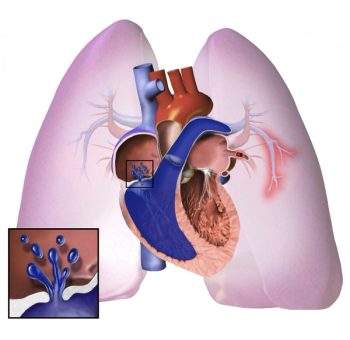
Detailing findings from the secondary end points of the FIREFISH trial at 24 months, the researchers found that risdiplam treatment was associated with continued improvements in motor function and the achievement of development motor milestones.
Jaime is a freelance writer for The American Journal of Managed Care® (AJMC®), where she previously worked as an assistant editor.
She has a BA in print journalism from Penn State University. You can connect with Jaime on LinkedIn.

Detailing findings from the secondary end points of the FIREFISH trial at 24 months, the researchers found that risdiplam treatment was associated with continued improvements in motor function and the achievement of development motor milestones.

A new study has found that a drop in serum inorganic phosphate (iP) was an early predictor of severe cytokine release syndrome (CRS), suggesting that monitoring serum iP levels could help promote safer management of the most common toxicity associated with chimeric antigen receptor (CAR) T-cell therapy.

Using data from patients with spinal muscular atrophy (SMA) type 1 and 2, researchers observed that chitotriosidase 1 levels in cerebral spinal fluid (CSF) changed over time after treatment with nusinersen, suggesting that the change could be indicative of treatment response.

The observational study found that 25% of deaths were premature and that mortality associated with rheumatoid arthritis (RA) resulted from cardiovascular, cancer, and respiratory causes

Zanubrutinib is the latest of 3 Bruton tyrosine kinase (BTK) inhibitors approved for rare B-cell malignancies, such as Waldenström macroglobulinemia, a non-Hodgkin B-cell lymphoma (NHBCL); as a next-generation BTK inhibitor, zanubrutinib is designed to have less off-target effects.

While chimeric antigen receptor (CAR) T-cell therapy has offered a new option and improved outcomes for patients with advanced hematologic malignancies, the treatment approach has been associated with toxicities such as cytokine release syndrome (CRS), neurotoxicity, and hematotoxicity.

Recent research suggested the idea of combining chimeric antigen receptor (CAR) T-cell therapy and Bruton’s tyrosine kinase (BTK) inhibitors for certain patients with advanced mantle cell lymphoma (MCL).

The retrospective findings showed that searching for Staphylococcus aureus and its enterotoxins (SE) when initially screening patients for asthma can help with identifying a targeted treatment option by improving phenotyping and predicting comorbidities.

Emerging therapies for psoriasis and psoriatic arthritis (PsA) include treatments that target interleukin (IL)-23 and IL-17, which could lead to the approval of new IL-23 and IL-17 inhibitors, as well as expanding the use of currently approved options.

The program, serving patients from rheumatology, dermatology, gastroenterology, allergy, and cardiology clinics, is the first of its kind within the Veterans Health Administration, researchers said.

The findings follow recent data suggesting that esophageal dysmotility may be associated with eosinophilic esophagitis (EoE), which often presents with dysphagia.

The study, say researchers, adds insight into risk factors predictive of response to dietary intervention for eosinophilic esophagitis (EoE), as dietary failure occurs in up to 30% of patients.

Highlighting their ability to quickly destroy malignant cells without antigen specificity, natural killer (NK) cells have been identified as an opportunity for use, particularly in cases where T cells are not effective.

In a proof-of-concept analysis, researchers show that machine learning methods paired with longitudinal patient-reported outcomes (PRO) data were able to classify subsequent rheumatoid arthritis (RA) disease activity after beginning treatment with a biologic

Data suggest that the technology may be an option for patients who are ineligible for autologous stem cell transplantation (ASCT) based on certain patient characteristics, prior treatments, stem cell availability, or tumor chemosensitivity.

While the prevalence of eosinophilic esophagitis (EoE) is estimated to be 0.5% in the general population, a recent study found that the prevalence was as high as 16.5% in patients with allergic disease.

Prior to the analysis, researchers hypothesized that having localized psoriasis on more visible and/or more sensitive areas, including the face and genitals, would yield a more significant impact on quality of life.

Risk of osteoporosis and bone fractures in rheumatoid arthritis (RA) stem from disease-specific causes, disease treatment, and factors that face the general population, according to researchers, who highlighted the importance of assessing risk factors in these patients.

Though typically associated with effects on the joints, rheumatoid arthritis (RA) was found have a pulmonary effect in nearly 3 in 4 patients included in the retrospective, single-center study.

In the last 2 years, the Group for Research and Assessment of Psoriasis and Psoriatic Arthritis (GRAPPA) and the European Alliance of Associations for Rheumatology (EULAR) have updated their recommendations to integrate guidance for new treatment options.

Researchers highlighted the opportunities primary care providers (PCPs) have to promote favorable outcomes through prompt diagnosis as well as help reduce racial disparities in multiple myeloma.

The study, which assessed changes in circRNA and miRNA after beginning treatment with secukinumab, revealed a prompt change in circRNA abundance upon initiation of treatment and a strong correlation between circRNA and the psoriasis area and severity index.

Based on their findings, the researchers are emphasizing the importance of patients with rheumatoid arthritis (RA) receiving a booster vaccination, as well as other mitigation strategies, such as social distancing and wearing face masks.

The exploration of whether early intervention has an impact in psoriasis follows data from other immune-mediated diseases in which evidence is mounting for the benefits of intervening early on in disease duration.

In the absence of a head-to-head trial, the researchers compiled data from randomized controlled trials of the 2 PD-1/PD-L1 inhibitors in patients with advanced disease and PD-L1 ≥ 50%.

Data showed that patients using diabetes technology incorporated different strategies to prevent nocturnal hypoglycemia vs patients who did not use such technology.

Overall, 65% of patients went into remission throughout the observation period, with those with concurrent eczema and pollen food syndrome (PFS) having favorable responses.

This new series of cases suggests that technology can help nurses remotely identify relevant health events that could be indicative of exacerbations or changes in their condition.

With these new findings coming from the EMPOWER-Lung 3 trial, the anti-programmed cell death-1 inhibitor cemiplimab is now just the second of its kind to show efficacy in these patients as both monotherapy and as a combination regimen, regardless of histology.

The findings, produced over a 4-year period, indicate the protein sulfatase-2 (Sulf-2) may be a therapeutic target in rheumatoid arthritis (RA).

259 Prospect Plains Rd, Bldg H
Cranbury, NJ 08512
© 2025 MJH Life Sciences®
All rights reserved.
